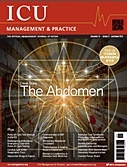Volume 16 - Issue 3, 2016
- ICU
- 27/09/2016
Change content default value
READ MORE
Recently a number of new antibiotics or combinations for complicated intra-abdominal infections have been introduced. Here we review the currently available data of these new drugs and discuss how they can be used in critically ill patients with complicated intraabdominal infections. Complicated intra-abdominal infections (cIAI) remain...
READ MOREThe enteral route is commonly accepted as the first choice for providing nutrition to patients in the ICU with stable haemodynamics and a functional gastrointestinal (GI) tract. However, there is wide uncertainty regarding safe enteral nutrition in patients with critical pathology in the abdomen. In the current review we address different abdominal...
READ MOREMost patients with liver cirrhosis remain in a compensated stage for more than 10 years, regardless of the aetiology of the liver disease. The progression to decompensated cirrhosis is defined by the occurrence of a major complication such as ascites, variceal bleeding and/or hepatic encephalopathy. From here on most patients will not die because...
READ MOREKnowledge of intra-abdominal hypertension (IAH) and abdominal compartment syndrome (ACS) is crucial for successful treatment of critically ill patients, whether medical or surgical, young or old (Kirkpatrick et al. 2013). Today we understand that IAH and ACS are frequent causes of increased morbidity and mortality (De Waele et al. 2016). More importantly,...
READ MOREEven though systemic haemodynamic variables may be normalised, there could be regions with inadequate regional oxygenation at the tissue level. The most recent developments of noninvasive monitoring of the peripheral circulation have helped physicians to early identify patients at high risk for tissue hypoperfusion, organ failure and poor outcome....
READ MOREIn contemporary healthcare, touch— contact between a doctor’s hand and a patient—appears to be on its way out. The expanding role of CT and MRI imaging is decreasing reliance on touch as a way of making diagnoses. Pressures to move patients through the system more quickly leave health professionals with fewer opportunities to make contact....
READ MOREMany patients presenting to the hospital emergency department do not need to stay overnight. Ambulatory emergency care (AEC) may optimise identification and management of such patients by delivering streamlined, efficient patient care within one working day. This may improve clinical outcomes, patient experience and lower costs. At James...
READ MOREThere is a significant gender imbalance in positions of leadership in intensive care medicine. This complex problem requires action to ensure high quality and sustainable leadership for our specialty in the future. Despite an increasing proportion of women in the medical specialty workforce, there are few female doctors in positions of...
READ MORE